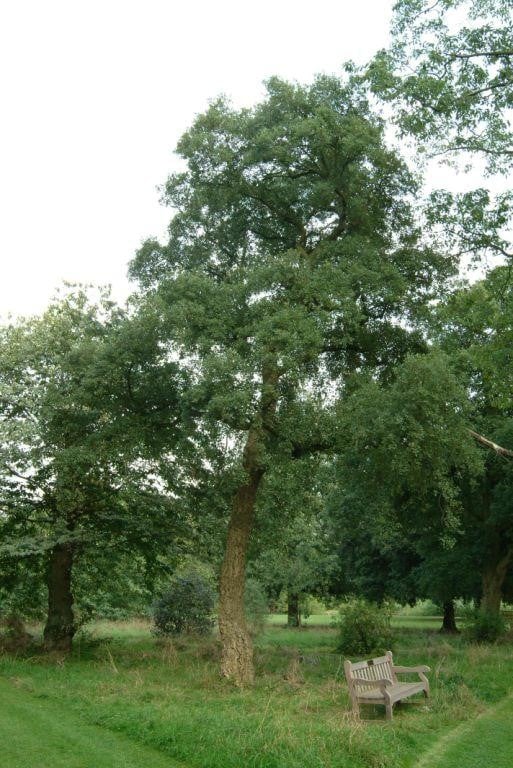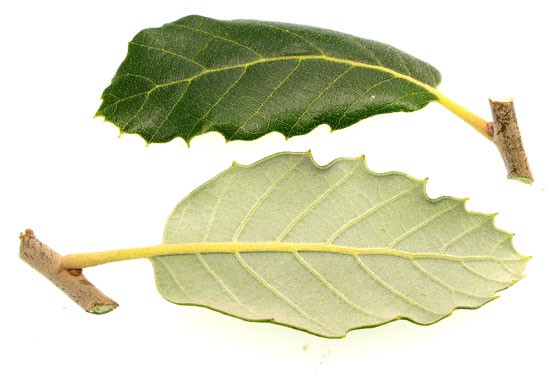University of Redlands Emergency Alert System
Alert Received: . For more information, visit: https://www.redlands.edu/alert/
University of Redlands
Classification
Common Name: Cork Oak
Scientific Name: Quercus suber
Family: Fagaceae
Identification
Habit: The cork oak is slow-growing and long-lived, usually surviving around 250 years. It is an evergreen tree with low, twisted branches and downy twigs. The cork oak usually reaches a height of 30 feet.
 Photo credit: Board of Trustees, RBG Kew n.d.
Photo credit: Board of Trustees, RBG Kew n.d.
Leaves: The top portions of the leaves are dark green and the bottom a paler green. They are 4-7 cm long and have spiny-ended lobes with margins curved downwards. The leaves are alternate and simple and every two years the cork oak sheds its old leaves.
 Photo credit: Board of Trustees, RBG Kew n.d.
Photo credit: Board of Trustees, RBG Kew n.d.
 Photo credit: M. Ritter, W. Mark and J. Reimer 2017
Photo credit: M. Ritter, W. Mark and J. Reimer 2017
Twigs & Bark: It has very thick and deeply ridged bark and downy twigs.
 Flowers & Fruits: Once a year, the cork oak produces indehiscent fruits, known as acorns. These acorns are 2-3 cm long and 1-4 cm wide and are fringed with elongated scales. The cork oak is the only oak species with annual and biennial acorns on the same tree. It has separate male and female flowers on the same plant and is pollinated by the wind. The fruiting phase of the cork oak is critical in regeneration.
Flowers & Fruits: Once a year, the cork oak produces indehiscent fruits, known as acorns. These acorns are 2-3 cm long and 1-4 cm wide and are fringed with elongated scales. The cork oak is the only oak species with annual and biennial acorns on the same tree. It has separate male and female flowers on the same plant and is pollinated by the wind. The fruiting phase of the cork oak is critical in regeneration.
Where it’s from
Native Range: The cork oak comprises forests or open woodlands. It is usually distributed in marsh-scrub ecotone or scattered over dunes near ponds. It is suggested that it originated in the Iberian Peninsula where it is most presently found. The cork oak is also found in the Mediterranean Basin and occurs in the coastal regions of southwest Europe and northwest Africa, including Algeria, France, Italy, Morocco, Portugal, Spain, Tunisia, and the islands of Corsica, Sardinia, and Sicily. It can grow in barren land with little rain or nutrition. The cork oak can grow in sandy soil with low levels of nitrogen and high levels of potassium. It grows best in areas with hot summers and cold, wet winters. It is most commonly found around 300-600 m elevation. This oak tree’s success depends on abiotic factors such as temperature stability and periods of drought. Biotic factors such as plant pathogens and insect pests also play a role in the cork oak’s survival.
Ecological Notes: The cork oak is a resilient, sturdy, and stocky tree. The acorns of the cork oak tree can be used to feed and fatten livestock since the acorns are full of carbohydrates and low in protein. Acorns from other oak species such as the red oak contain higher amounts of bitter tannins than the cork oak species, contributing to their sweet, nutty taste. The cork oak produces acorns, which birds and mammals disperse effectively. Increase in agriculture and forest fires caused by humans puts the cork oak under threat. Many phytophagous insects feed on Querces suber trees with the most damaging groups being defoliating insects and bark- and wood-boring species. Moths are the most damaging of the defoliating insects. Another damaging pest includes Platypus cylindrus, an ambrosia beetle native to Europe that digs tunnels into the wood and injects fungal ectosymbionts that contribute to the decline and death of the cork oak.
What we use it for
The cork oak’s most notable contribution for human use is its bark. Its bark is transformed into cork bottle stoppers and used as insulation material. It can also be used for flotation, shoe insoles, gaskets, and notice boards. In the past, cork was used as insulation for buildings, keeping warm air in during winter and out during summer. Cork can be harvested from a single tree 12 times in its lifetime. It is done by peeling away the bark from the trunk and leaving the thin layer of cork underneath. At 25 years of age, the cork can first be harvested and following this can be harvested every 9 to 12 years. The cork grows back on the trunk, making it a renewable source for human use. The first few harvests produce low quality cork, called virgin cork. The inner part of the cork oak is an important source of tannin, which is used in traditional medicines, food processing, and leather production. Portugal provides 50% of the world’s cork supply, making it the biggest cork producer. According to the Cork Quality Council, the Portuguese estimated revenue in 2015 was € 899 million euros and the US revenue € 140.9 million euros. The cork oak forest also has economic value by providing cropping, grazing, hunting, honey, mushrooms, and farming of livestock. Querces suber is also used as an ornamental tree in parks, gardens, and around our campus.
References

Biographer: Cayman Scott ’19, BIOL 238: Evolution, Ecology, & Behavior, Fall 2017